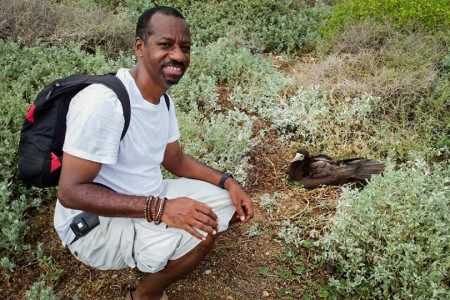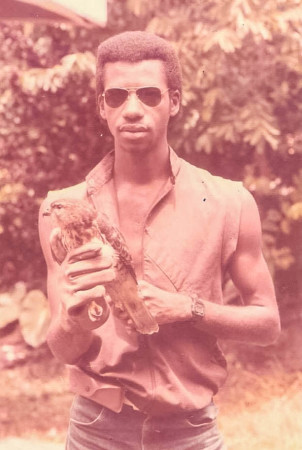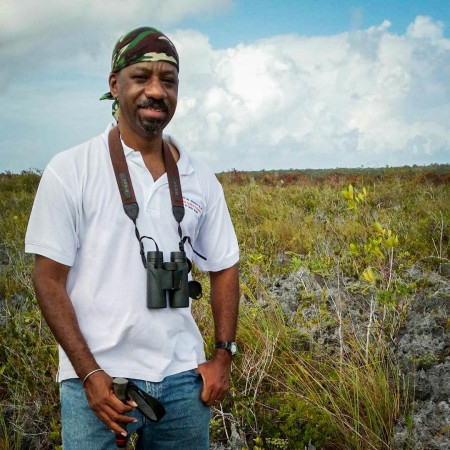
What is your job (currently and in the recent past if different from you current position)?
I am the Caribbean Invasive Alien Species Project Coordinator with Royal Society for the Protection of Birds (RSPB) responsible for management of the EC funded BEST project entitled “Conserving Species and Sites of International Importance by the Eradication of Invasive Alien Species in the Caribbean UK Overseas Territories.”
I have enjoyed a career spanning some 30 years much of it as a conservation biologist and a forester with the Saint Lucia Department of Forestry. I started off as a tour guide with subsequent appointments as a research officer, wildlife officer and eventually to Assistant Chief with acting appointments as Deputy Chief Forest Officer and Chief Forest Officer.
How did you get interested in birds?
While I am a native of Saint Lucia, much of my early childhood was in urban Jamaica where I did not get to see much more than commonly seen garden birds or sometimes waders along the canals of the Portmore area. However, natural history television programmes (e.g. Jacques Cousteau) and reading (e.g. Gerald Durrell) sparked my early curiosity for the subject of wildlife in general. Upon my return to Saint Lucia as a teenager in high school, I became a member of the then St. Lucia Naturalists Society and participated in field trips covering various aspects of St. Lucia’s fauna and flora during which I gained a greater appreciation for native and migrant birds.

In 1986, I was recruited as a tour guide with the Saint Lucia Department of Forestry. Due to my enthusiasm specifically for the wildlife component of the Department’s programme, I was invited to attend the 1990 meeting of the then Society of Caribbean Ornithology (SCO) in Jamaica by Mr. Paul Butler and then Chief Forest Officer Gabriel Charles. I accompanied both gentlemen to the meeting which was held at the UWI, Mona Campus. This was my first international wildlife meeting of what has since been a lifetime of professional related travel.
How has the organization influenced you?
I thoroughly enjoyed the international meetings of then SCO, (currently BC) because although I was a novice in the field , I met fellow members from all over the region who were also just getting started in their careers. Some would eventually serve at the highest levels of the organization and also in offices from their respective countries. It served as an excellent basis for networking and fostering our keen interest as budding conservation scientists. It also introduced me to mentors such as Dr. James Wiley, who would become my professor during my undergraduate studies in Biology (Wildlife) at Grambling State University, Louisiana, USA. Herb Raffaelle, Joe Wunderle, Ernesto Garcia are among the many who encouraged and influenced my career.
Additionally, I became the first Forest Officer in my Department to be awarded a grant directly. The cash grant of US$1500.00 US in 1992 enabled me to conduct research on the White breasted Thrasher, a critically endangered St. Lucian species. The project entitled “Conservation of the White breasted Thrasher (Ramphocinclus brachyurus sanctae luciae). also enabled me to purchase field gear for the wildlife unit of the Department. The grant was provided by BirdLife International and U.S. Fish and Wildlife Service through SCO (BirdsCaribbean).
What does being a member of the board mean for you?
Being a board member of BC allows me to give something back to an organization that influenced my youth and career as a conservation biologist.

The Caribbean consists mainly of a youthful population, with struggling vulnerable economies and a political emphasis on traditional outmoded model of development based largely on conversion of natural landscapes. The biggest challenge to Conservation is that it needs to answer the demands of the region’s societies for sustainable development, while making every effort to showcase the immense, irreplaceable social and biological value of our birds and their habitats as part of the solution in our drive for development.
If you could encourage people to do one thing for birds, what would it be?
Value them and their habitats! To value them, one must come learn about them. You cannot value what you are not aware of, nor do not understand. In so doing, I hope this would reveal the tremendous value, actual and potential contribution of birds to the Caribbean.
What was your most rewarding education/conservation/research success?
During my 1992 research on the project entitled “Conservation of the White breasted Thrasher (Ramphocinclus brachyurus sanctae luciae). I discovered that the chicks were precocial in behavior and that they left the nest before they could fly. I got video footage of this behavior which had never been described for the species before this study. Additionally, I’d say getting Saint Lucia to ratify the Ramsar Convention on Wetlands in 2001 and adding the Mankote Mangrove and Savannes Bay Mangrove to the list of Internationally protected wetlands, thereby protecting valuable habitat for native and migratory birds.
